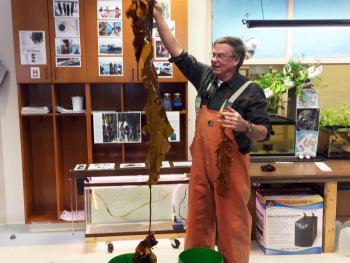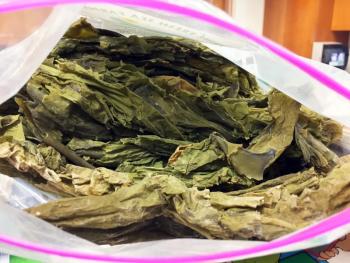Have you ever wondered how seaweed starts its short life, or how long it takes to grow to maturity? How about those long, flat pieces of kelp you’ve seen floating out in the ocean, or attached to docks and piers — the ones that get caught up in your outboard engine? Ever wondered how they came to be?
Probably not. But there are a couple of guys in Walpole whose lives pretty much revolve around seaweed. They’ve made it their mission to produce different types of edible seaweed.
Seth Barker and his partner, Peter Fischer, are the owners of Maine Fresh Sea Farms in Walpole. They are seaweed farmers.
A marine biologist, Barker has been involved in the marine science and fisheries fields for over 40 years and is focusing on the farming and sustainability of seaweeds — specifically sugar kelp. He has worked in both the private and public sectors, including ecological studies for Raytheon Corp., managing a fisherman’s cooperative, and working with the Gulf of Maine Council on the Marine Environment.
The farm at Clark Cove is set up to grow seaweed on ropes, 200 to 600 feet long, three to six feet below the surface of the ocean or river. Barker compares the process to land farming.
The farmers start with seaweed seedlings. “Just like you'd sow a row of corn, we seed a rope and it grows from that,” he said.
Right now the farmers are focusing on three different types of seaweeds: Sugar kelp, winged kelp (Alaria) and dulce, a red seaweed. The farmed seaweeds are being sold as far away as New York, but the farm supplies 16 restaurants in Portland. The seaweed is used in a number of different dishes, including a stock for flavoring, in soups and chowders, as a wrap around fish and scallops, and in salads. “Seaweed will add relatively inconspicuous additions to a recipe,” Barker said. “It has a big impact in terms of flavor, and health.
“Imagine a lobster bake. The seaweed imparts a fairly unique flavor to the lobsters and clams.”
Barker said his business is focused primarily on fresh seaweeds, but is also getting into the dried seaweed market. Hannaford and Rising Tide in Damariscotta each have a small section of dried seaweed products. Barker said seaweed for consumption is slowly catching on. “The market may have a lot of potential, but it's an unrealized potential at this point. It's not a big part of the American diet yet.”
Seaweeds have a fairly complex life cycle, according to Barker. They are started from spores that germinate from microscopic male and female plants that grow into much larger spore-bearing plants. Some of Maine Fresh Sea Farms’ seedlings have been raised at the Darling Marine Center in Walpole.
Barker said his team has been experimenting with nutrient sources to start seedlings that would meet organic approval by MOFGA (Maine Organic Farmers and Gardeners Association ), and the farm has now obtained organic certification for both seedlings and the farm where they are grown.
Sugar kelp takes four to five months to grow to maturity, and last year the farm produced around 20,000 pounds of it. Unfortunately, only 5,000 pounds of the kelp sold. “We took a couple truckloads to a local farm to use as compost,” Barker said.
According to Barker, there's a good potential for selling dried seaweeds overseas. Worldwide sales may reach $22 billion by 2024. Presently, he estimated they are valued at around $8 billion. So there's a lot of room for growth, but right now Barker said he and Fischer will continue to focus on regional sales.
“We feel that we can make a contribution to local aquacultural production by having a relatively small farm in Clark Cove, and perhaps some other farms in other locations. That will be determined by other types of seaweeds that we'd like to grow.”
For his business to grow, Barker will need to build up his seaweed sales to Maine restaurants. Next time you go to a restaurant, look for a seaweed salad on the menu. It will be delicious, and full of nutrients.




























